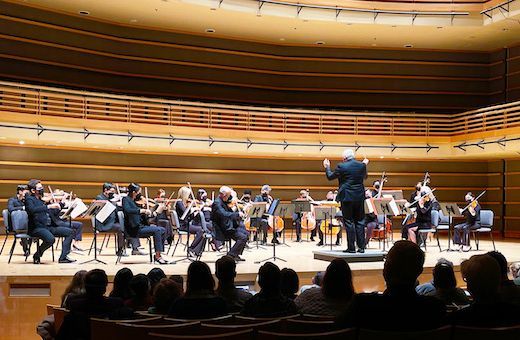Amid the coldest days of winter, the Chamber Orchestra of Philadelphia offered a program that charted a chilly journey through the valley of death, with a warm, shining reprieve at its center. Benjamin Britten’s Serenade for tenor, horn and strings stood in stark contrast to meditations on mortality from Schubert and Adolphus Hailstork – a study of our nature, to be sure, but not one shrouded in rising anxiety and impending doom. The entire 90-minute program emerged as a comment on the cycles of life we must consider and endure, balancing pain and pleasure in an attempt to give full voice to the human experience.

The Serenade skirts the fringes of standard repertory, perhaps due to the demands it places on an orchestra and its soloists. The tenor should possess a voice of stentorian authority, but he also needs a clearly articulated, bright tone that can communicate youthful wonder. The natural harmonics that Britten favored for the French horn solo writing can sound amateurish in the wrong hands. Composing after a brief period spent living in the United States, Britten also selected a series of unfailingly English poetic texts, often with a pastoral theme, that can sound like juvenilia if they aren’t imparted with serious consideration.
Conductor David Hayes recruited ideal partners in tenor John Matthew Myers and horn soloist John David Smith. Even singing with carefully controlled dynamics to suit the intimate acoustics of the Perelman Theater, a listener can sense the raw power of Myers’ voice; his middle voice is especially rich and supple. Some of the highest notes in Nocturne (text by Alfred, Lord Tennyson) came out slightly bleaty, but overall, Myers’ sound is evenly produced and gorgeously colored throughout its range. He brought dramatic conviction to each reading, from the creeping uncertainty of the Elegy (after William Blake) to the bright and hopeful mythology of the Hymn (text by Ben Jonson). Myers’ overall performance achieved a certain dreamlike quality that suited the nighttime setting evoked by the work’s title, without growing hazy enough to eclipse its meaning or momentum.
Smith matched Myers in purity of tone and assured interpretation. He drew attention to nuances in the Prologue and Epilogue that charted the work’s progression, while also underscoring musical themes that recur throughout the cycle. Hayes brought out a transparent texture and rounded, mahogany color from the string orchestra, which played with greater clarity and cohesion than I’ve heard since they returned to live performance last fall.
The orchestra sustained that crisp precision in Schubert’s Death and the Maiden, heard in the arrangement begun by Mahler prior to his death. Originally written as a string quartet, it gives an almost painfully clear account of the composer’s physical decline, with restless repetitions and breakneck shifts from beauty to terror and back again. Hayes kept up a propulsive momentum throughout, building to a tarantella in the concluding Presto movement that truly felt like a dance of death.
Schubert’s anxious exploration of life’s end contrasted strongly with Hailstork’s Essay for Strings (1986), written in tribute to a colleague who died suddenly. Where Schubert’s music overflows with drama, Hailstork instead prefers a sustained mood – it feels like the experience of grief. The brief piece concludes with hopeful glissandi, creating a sense that one can ultimately leave the darkness behind.


